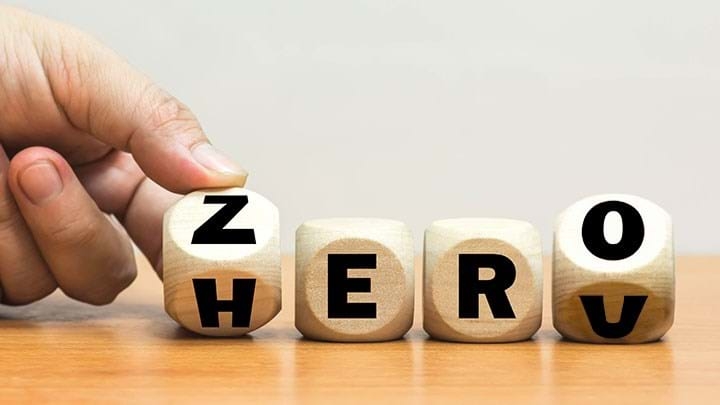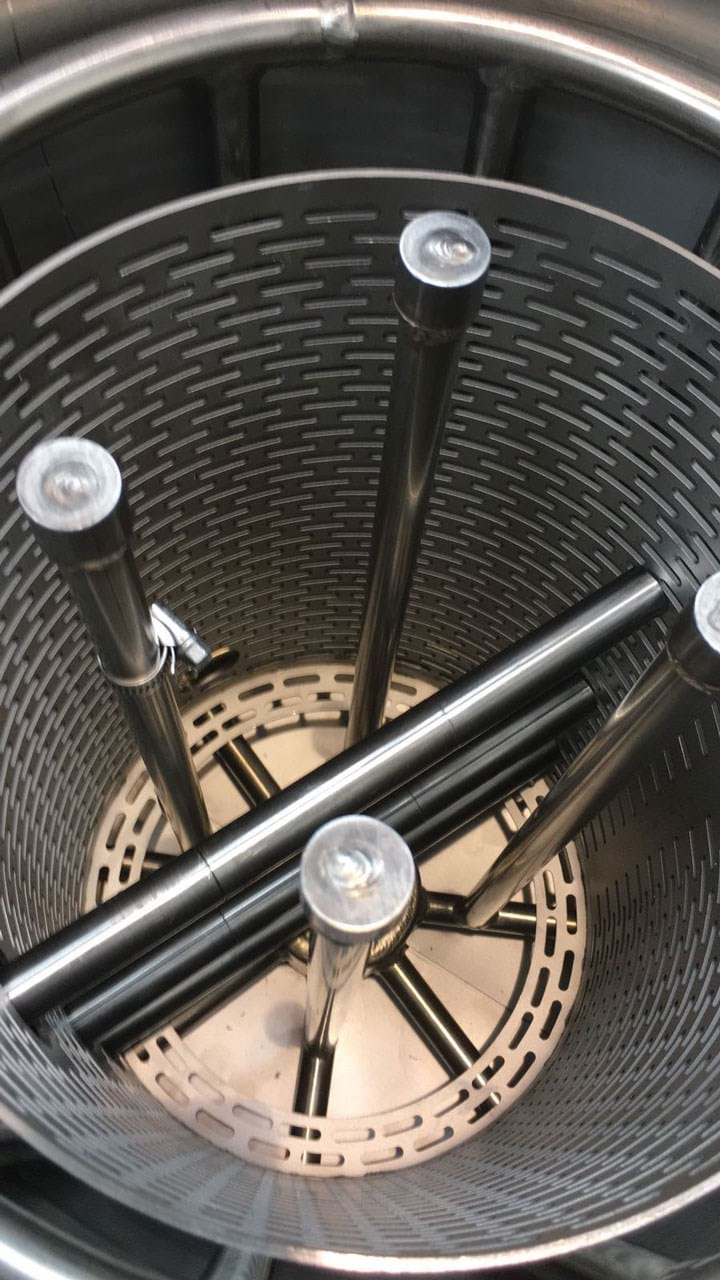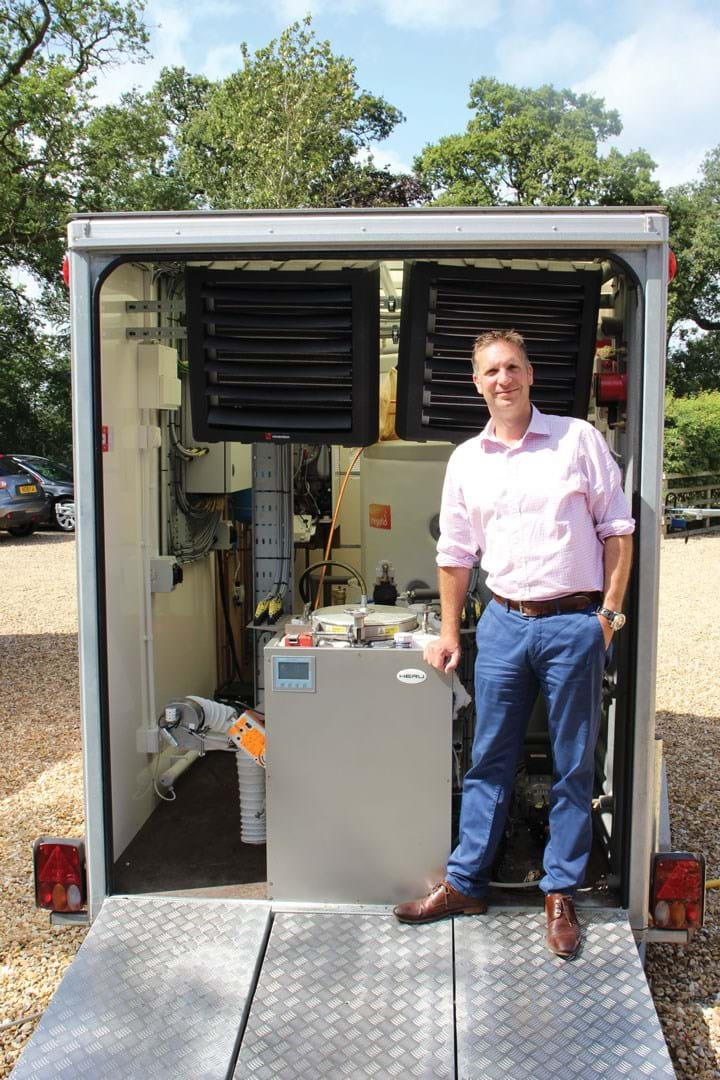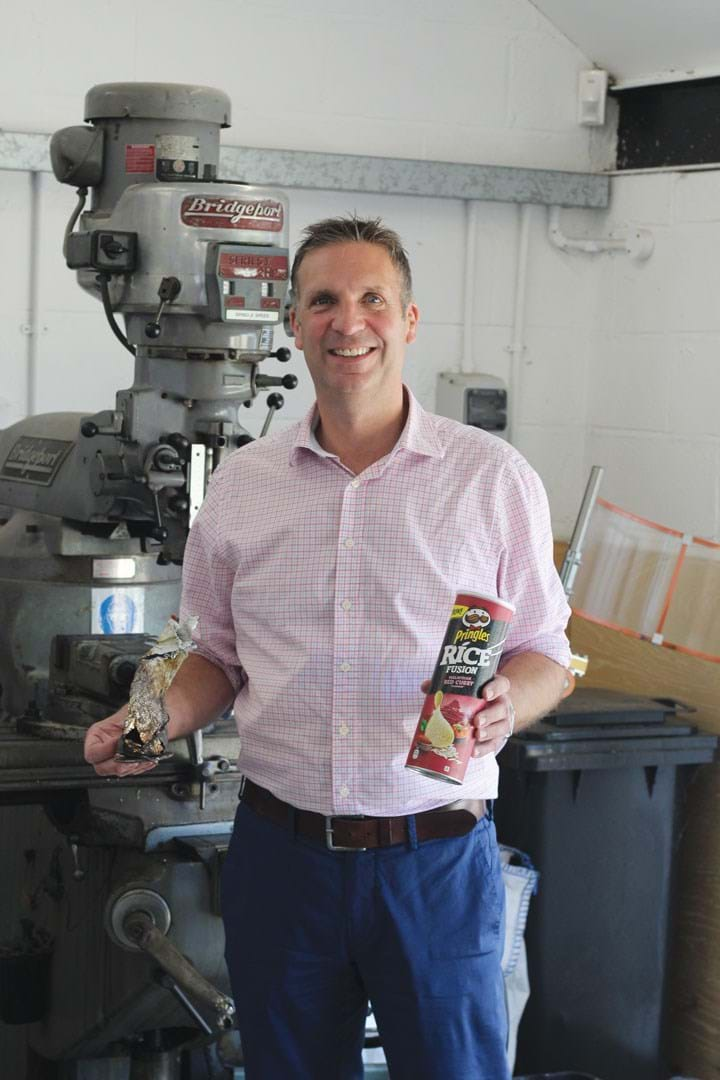Pyrolysis Gets Personal
Adam Duckett visits the workshop of Nik Spencer to understand more about a pyrolysis unit that allows homes and businesses to process waste into gas for heating

IMAGINE a world where instead of having your household rubbish carted off to landfill or a recycling centre you simply ‘burned’ it cleanly in a device at home to heat your own water.
That future might be closer than you think after Nik Spencer who, after decades of working in the recycling industry, set out to develop a pyrolysis unit – called a HERU – that is as simple to use as a wheelie bin and is set for commercial launch later this year.
Wave goodbye to your waste. Wave goodbye to the rubbish truck ferrying your waste to landfill. In fact, why not wave goodbye to the word ‘waste’ altogether?
Two technical evaluation units have already been used at a farm shop and a local council cafe close to Nik’s workshop in the UK’s Worcestershire countryside. And as we go to press, a third unit is being put through its paces close to IChemE HQ in Rugby where residents at a local sheltered housing scheme are using it to process their household waste into heat.
The concept, part funded by the UK Government in 2017, is appealingly simple: a waste-to-energy plant connected to a boiler, hot water tank and your drain. Open the device’s lid. Put in your rubbish. This can be anything from spoiled food and grass cuttings to used nappies and plastic packaging. Close the lid. Press the ‘on’ button. Walk away.
Wave goodbye to your waste. Wave goodbye to the rubbish truck ferrying your waste to landfill. In fact, why not wave goodbye to the word “waste” altogether? Your domestic ‘waste’ is now a valuable resource that you can use to heat your home.
From racehorses to redundant rubbish trucks
For those unfamiliar with pyrolysis, Nik describes it as a natural process, sped up. In simple terms: bury a dinosaur or a tree in the earth in a lack of oxygen and wait for millions of years as the heat from the earth transforms it into hydrocarbons.
“What the HERU does is exactly that same process but reduces it from 5–9m years to 5 hours of pyrolysis,” Nik says.
Of course, the technology behind this concept is far less simple. But before we get to that, it’s worth knowing how Nik came to invent such a device.
He studied animal husbandry and agricultural engineering and after finishing his studies established a business turning used newspaper into bedding for racehorses. The advantage with paper over the likes of straw is that horses won’t eat it, so trainers can better control their diets. The business took off so fast that Nik needed another to get his hands on more used newspapers. “By accident I became the first kerbside recycling company in the UK.”
This outgrew the bedding business and he ended up with more newspaper than he could process.
“I started trading newspaper to paper mills in the UK and Europe, and then more latterly to paper mills all over the world.”
He sold the recycling business and kept the commodity trading business. From here he invested in 180 recycling trucks and leased them to local authorities that lacked the funds to buy their own. Nik went on to set up and sell a number of recycling businesses and facilities before he realised it was “mad” driving fossil-fuelled lorries to and from homes collecting fuel for waste-to-energy plants and then sending the energy back to people’s homes. He asked: “Why don’t we just cut out all of that carbon producing infrastructure and just have a machine in the home?”
His journey developing the HERU unit was now underway.
Thinking inside the box
“I knew we couldn’t incinerate, and I’d been looking at pyrolysis for years. I found it really fascinating because it’s such a natural process and you can rarely argue with nature.”
Nik wanted to engineer a device that would be as simple to use as a wheelie bin: just open the lid, put in the rubbish, and walk away.
He was told by a professor who focussed on pyrolysis research that creating such a simple operation would be impossible because the feedstock would need to be pre-treated to dry it, shred it and auger it into the machine. Nik admits it was a disheartening start.
But he was then introduced to Hussam Jouhara, a heat exchange expert and researcher at Brunel University London, who put Nik on the trail of thermosyphons. In simple terms these are sealed pipes used to transfer heat – in this case to the resource being pyrolysed. They contain a working fluid that is circulated by convection rather than a pump.
“If we could use those, that would inject all the energy into the middle of the chamber…so we don’t have to do pre-treatment.”
Others had tried putting heating elements around the outside but this combusted the resource unevenly. The device might gasify material close to the walls of the chamber, but moving inwards you might get high temperature pyrolysis, low temperature pyrolysis and then no effect in the centre.
“So, if the nappy falls into the centre of the chamber, nothing is going to happen to it.”
Nik instead created a device in which the heating elements – four patented thermosyphons – protrude into the centre of the chamber.
“It doesn’t matter where you throw that nappy; you’re going to get this perfectly uniform 300°C. That was the big breakthrough for us.”

Three stages of operation
The user puts in the waste - but let’s now call it ‘resource’, screws down the lid so that it is airtight, and using the touch screen they turn it on. What follows is a three-stage process: drying, pyrolysis, combustion.
A 3 kW element heats up the water in the thermosyphon which is under vacuum so boils at 45°C. This rises to the end of the thermosyphon pipe and its heat is dissipated into the chamber; it then condenses and flows back to the heating element, and on it goes.
Nik explains that municipal waste on average contains around 35% moisture: food is around 70%; garden trimmings 55%; and cardboard 10%. The HERU heats up the resource, boiling off its moisture. The resulting steam passes over two heat exchangers, condenses. and the water runs down the drain. The captured heat is used to heat water in a connected hot water tank.
With the moisture driven off, and the chamber now at around 220°C, pyrolysis gets underway. The dried organic material begins to decompose in the absence of oxygen as the temperature in the chamber rises to 300°C. It produces a very small amount of oily vapour that passes over the heat exchangers and condenses. The oil content (around 5% on average) along with any chlorine is washed off the face of the heat exchangers with a detergent and flushed down the drain, like how your dishwasher disposes of the oil cleaned off a dirty frying pan. Removing the chlorine at this stage avoids dioxins being produced during the combustion stage.
The syngas coming off the heated material is scrubbed through a water screen filter, passes through a cyclone to spin off the moisture, through a 5 µm filter and a compressor, and then into a 25 L storage tank until its needed by the boiler.
We’re now around five hours in; the gas and oil are dealt with and all that remains of the resource is char at 300°C. The machine opens a valve that introduces air to combust the char, producing a gas rich in carbon monoxide and nitrogen oxides.
“The exhaust goes over the heat exchangers and we extract the energy and put it into the hot water system.”
The exhaust gas then passes through the water screen filter which uses an alkaline solution to scrub out the nitrogen oxides and remaining oily vapours.
“We turn them into a nitrate and put them into the water. This water is then later used in the washing process.”
The exhaust gas then passes to the storage tank with any carbon monoxide in the stream fully combusted when it’s passed to the boiler. As with any boiler the resulting CO2 is vented but Nik notes it does not come close to exceeding regulatory limits.
Nik says the average mix of resources produces around 2 kWh for every 1 kWh put in, and the company that has licensed the technology for commercial unit production is working to further increase the energy efficiency.

Fighting fatbergs
“Then you’re left with ash at the bottom of the chamber. Now, at one point I thought this is going to be really inelegant because we’ll have to take the ash out of the machine by hand.”
Nik worked with Brunel University to test the ash and discovered it contains a gritty substance called lye. This helps clean the drains – as it did when the Victorians used to flush ash from their burned waste into the sewers – and because it is alkaline it helps neutralise the sulfuric acid drained to sewers by modern boilers, which inhibits the bacteria used in water treatment plants.
So, the final stage simply involves the HERU pressure-washing its own innards to flush the ash down the drain.
“The sewage companies love the lye because the HERU takes the fat element and turns it into energy…Our system will eliminate fatbergs and send the sewage company a product that will scrub the drains.”
“And that’s it. The machine must cool to below 40°C before you can open it again. Like a washing machine it has to finish its cycle.”
Then, he says “you refill and off you go again.”
Asked about the safety challenges overcome, Nik points out the thermosyphon is a pressure vessel so has a rupture disk, and there is a UV sensor that checks the boiler is on before any gas is sent its way. He has also tested the machine by adding materials he’d rather people not put in, such as batteries and full aerosol cans. The HERU is not damaged, batteries come out whole, and aerosol cans have their nozzles and contents pyrolysed and combusted leaving only the metal container for recycling.
Packaging problems
Nik is bullish about additional benefits, saying the system can also improve the materials we send for recycling. Add glass and metal to the HERU and they merely come out clean. Labels and any traces of food are removed but the temperature does not get high enough to alter the metal or glass. The user can simply take it out of the HERU and put it into their recycling bin.
Users could help improve recycling by pyrolysing their wastepaper too. As fears grow about identity theft, people have taken to shredding their wastepaper before they put it in the recycling bin. This creates a problem at mixed waste recycling facilities where glass is broken down and passed over screens to separate it, but also pulls through shredded strips of paper, contaminating the stream.
If the HERU were to become widely used, and only glass and metal were being added to recycling bins, it would make the job of recyclers much easier.
“You can mix metal and glass together and it can be very simply separated with a magnet and eddy current.”
It can also help deal with complex packaging such as laminated pet food sachets and Pringles tubes whose combination of materials make them a huge recycling challenge.
“The Pringles container has a lot going on. You have the steel on the bottom, the aluminium foil [lining the tube] the cardboard tube, a laminate on top and then the plastic lid.”
The HERU pyrolyses everything but the metal, which can then be sent for recycling.
Asked about its drawbacks, Nik says candidly: “the cost”.
“It’s made out of stainless steel 316L, which is expensive. You need to make it out of that because it needs to deal with the chlorine element.”
The current system is built inside a trailer so it can be moved for demonstrations. My first impression is that it looks rather unrefined, its electrical lines criss-crossing the space in a chaotic fashion. It appears unfinished because it is. Nik was advised by Baxi, the boiler company he is working with, to avoid having a printed circuit board made until at least eight months has passed without a software modification.
Once fully developed, a domestic unit would be the size of a standard dishwasher. Users could have it installed in their kitchen, garage, or outside, though Nik cautions that due to the economics it could be some time before you can nip into your local electrical store and buy one. The initial focus is selling to businesses.
“The commercial rollout has to be the immediate priority – that isn’t to say we wouldn’t look to do the domestic one for customers who want them.”
A large domestic take-up is likely to hinge on incentives for customers, such as local authorities giving back the portion of tax paid to collect household waste.

Holding out for a HERU
The three existing demonstration units have a 19 L capacity. Nik has licensed the technology to James Clark Technologies which is now developing a 240 L prototype unit for business use. Ten of these units will then be manufactured for early adopters – including a hotel, cinema, hospital and adult care home – which are expected to be delivered in Q3 this year. These units cost approximately £30,000 (US$39,000). The cost will fall as production increases but for now he expects the return on investment will be around five years.
“Adult care homes have got incontinence pads and bed pads, and they are expensive to dispose of so the ROI for those will be even quicker.”
Hotels should also see a faster return because they produce a lot of ‘waste’ and use a lot of energy, Nik explains.
So, what about industry? Are there plans to scale larger?
“There are, yes. I’m under a confidentiality agreement but there are discussions to build a 6m tall one that will hold up to 200 t at a time. I can’t really say too much more about that.”
Nik says his vision for the HERU project is for every home and business to manage their valuable resources at source.
“We will follow the first ten commercial early adopter units with 100, then 1,000 and then full production, to ensure quality; the domestic HERU to follow the same path, beginning with new-build homes.”
Discussions are taking place for three factories in the US and Nik would also like production in Asia.
“Henry Ford created the Model T Ford due to his horror at seeing horse manure in New York City. We have the same issue today but it is hidden away in CO2 and buried in holes ‘out of sight, out of mind’, until recently where we are seeing evidence of this pollution in our oceans and horrific fires in Australia. Imagine if we could see it in the streets today, what would that look like?”
Recent Editions
Catch up on the latest news, views and jobs from The Chemical Engineer. Below are the four latest issues. View a wider selection of the archive from within the Magazine section of this site.




